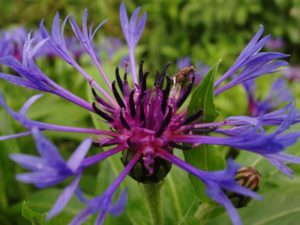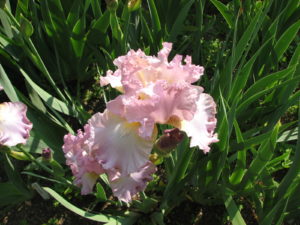Six Summer Beauties
I love the song “Summertime” by George Gershwin. Yet I fail to comprehend why Gershwin didn’t include any flowers in the song. Yes, the cotton was high and the fish were jumping. So what? There’s no mention of peony or iris. Let’s look at some great flowers of summer he might have included.
Starting in late May, bachelor buttons (Centaura montana) adorn my landscape. Big, bold blue flowers, each a work of art. Actually, they now come in more colors than blue: white, purple, pink, bi-color and more. They love full sun but are not too fussy about their soil, though good drainage is important. Divide them in the fall every 2 or 3 years to keep them vigorous, and cut them back after blooming if you want a second show in the fall.
Bleeding heart (Dicentra spectabalis) is another early summer favorite. The stems are 2 to 4 feet long, arching over on hollow stems that originate in a central point and go in all directions. Pink heart-shaped blossoms hang down from the stems. Morning sun or part shade is best for this one, and rich soil. Hot afternoon sun will yellow the foliage early, so avoid it.
June is peony season for me. They come in pink, white, red and more. They come as singles (with just one circle of petals) or as doubles (with many petals). Yes, they flop when it rains, so I install stakes around them, and surround them with string to keep them upright. Singles can stand up to rain, most times.
Peonies last forever. I have one of my grandmother’s, and she died in 1953. If yours doesn’t bloom, you have buried the growing point, or eyes, too deep. They should be covered with just an inch of soil, not more. And keep back the mulch, which will act as soil in discouraging blooming. Peonies need lots of sun – 8 hours or more for best results. Some of mine were getting shaded, so I removed a lot of branches from a nearby tree last summer, and this summer they are much more impressive.
Iris pair up well with peonies. Many types of iris will bloom with peonies, and their purples and blues go well with them. There are several species including Siberian, bearded, and Japanese iris. Each has its own benefits and needs.
The Siberian iris (Iris sibirica) I grow are very intense purples and blues, though whites are available. They have long narrow leaves that are 2 to 3 feet long and stay handsome all summer. They will bloom in part shade, but prefer full sun. Older clumps tend to die out in the middle, largely because the plants have used up all the nourishment in the soil. To avoid this, sprinkle organic fertilize over the clump once a year, or divide and re-plant clumps in the fall.
Bearded iris (Iris hybrids) can produce very showy larger blossoms in a wide variety of colors, some of them quite flashy. Their leaves are wider than those of Siberian iris, up to and inch and a half wide, and a lighter green color. When dividing or planting the rhizomes (roots), be sure not to bury the rhizomes or they will rot. Just settle the rhizomes into the soil with the top half above the soil line.
Japanese iris (Iris ensata) love moisture. They can grow in standing water, or moist soil in full sun or partial shade. These have wide flowers, up to 6 inches across. These are great cut flowers but do not last too long in a vase.
Two other summer beauties aren’t blooming yet for me, but will soon: hollyhocks and beebalm. Both are worth having.
Hollyhocks are biennials or, sometimes, short-lived perennials. They are easy to start from seed – the seeds are large enough to handle individually, and I have found their germination rates near 100%. Last year I planted 32 seeds in 4-packs, one per cell, and every one grew! I scattered the small plants around the flower garden, and this year they will reward me with 5-foot tall stalks that bloom from bottom to top.
As biennials, hollyhocks should die after blooming in the second year. I have found that if you cut the stalks down after blooming is finished, you are much more likely to get the plants to come back and bloom again the following year. On the other hand, if you let the stalks stand, they will drop seeds – some of which will grow the following year.
Beebalm is another favorite of mine. I love the minty fragrance of the blossoms and the leaves, which can be used in herbal teas. Hummingbirds love them, too. Most of mine grow 4 or 5 feet tall and spread by roots that adventure off into nearby spaces. Fortunately, the wandering plants are easily uprooted if you don’t want them.
Two years ago I discovered miniature beebalm. There is a trademarked series of beebalms, “Balmy Pink” is one. I also have purple, rose and lilacs miniatures. As trademarked plants, one cannot propagate them. For me it has not spread by root, though each clump gets bigger across each year. It grows to be 12 to 16 inches tall. A nice, tidy plant. Other companies have trademarked miniatures, including the “Petite Delight” series.
It’s true that I want to try every new variety of perennial that appears on the market, but sometimes the old favorites are best. I still love my grandmother’s ‘Festiva Maxima’ peony and feel lucky to have it.
Read my blog at https://dailyuv.com/





